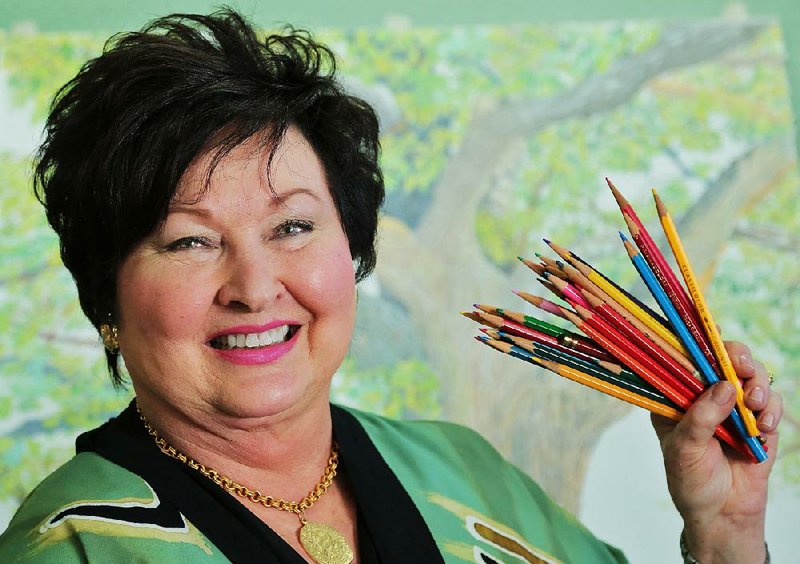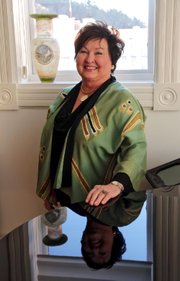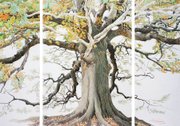A letter from a stranger led Linda Palmer to a tree -- a really big tree.
That tree led to another and another and another and all of a sudden, Palmer found herself in an Emmy-winning documentary and the artist behind a traveling exhibit of 18 works of art. Well, maybe it wasn't "all of a sudden." She did put more than 7,000 miles on her SUV looking for trees and spent hundreds of hours creating the artwork.
Linda Williams Palmer
Date and place of birth: Oct. 2, 1942, Checotah, Okla.
For inspiration I turn to nature — trees, flowers, rocks, landscape.
A perfect day would involve going out and searching and finding a wonderful champion tree.
I can’t live without my faith, family, friends and art.
My nickname is the Tree Lady.
My favorite color is green
My dog’s name is Girl.
The artist I most admire is Georgia O’Keeffe.
My Saturday morning ritual includes coffee, the paper, the crossword puzzle, then I go downstairs to my studio.
Every morning I get up at 6:30.
I drive a Toyota Venza.
My hero is my mother, Lola.
I won’t eat lamb.
One word to describe me Blessed.
Palmer, 72, has always preferred to focus her art on nature. She didn't know about "champion trees" until she got a letter from Frances Oyler. In the letter, Oyler gave directions to a tree near Keo.
To explain, a champion tree is the largest tree of a species based on its "bigness" -- circumference, height and crown spread. The state Forestry Commission keeps up with the list. Now, the letter.
Oyler wrote to Palmer after she saw a newspaper story that included a photograph of a tree Palmer had drawn. The artwork, called The Great Mother Tree, was a colored pencil drawing of a gnarly old live oak in the Texas Hill Country. In the letter, Oyler told Palmer that if she thought that tree was big, she ought to go out and see this one near Keo.
Oyler also suggested that Palmer make a day of it -- lunch at Cotham's, dessert at Charlotte's Eats and Sweets, and shopping at Morris Antiques. Palmer took her up on the offer.
"We got to the tree and it was one of the most fabulous trees I've ever seen in my life. It was huge and I knew it was some kind of oak, but I didn't know what kind of oak. It was perfectly shaped, it was huge, it was just wonderful," Palmer remembers from her 2007 visit.
She photographed it and headed home, where she ran into Jean Wallace, director of the Hot Springs parks and trails department.
"Jean said if it is that big and that wonderful and that beautiful, it must be on the champion tree list. I said, 'What are you talking about? I've never heard of that,'" Palmer recalls.
'A MAGNIFICENT TREE'
Now 94, Oyler describes the bur oak as "a magnificent tree. It was so big and it had a large, long limb that went way out and low on the ground." A tornado felled the tree several years ago.
Oyler, who grew up near Keo, has never seen Palmer's art in person but did buy a packet of Palmer's notecards featuring some of the champions.
"There was one of the tree," Oyler says of the notecards. "I foolishly used it -- sent it in the mail -- and didn't keep a copy of it."
Raised on a farm in Checotah, Okla., Palmer spent her childhood daydreaming and playing in the woods. In the documentary, Palmer says "anyone that is around trees as a child feels that enchantment." The Champion Tree documentary was produced by Arkansas Educational Telecommunications Network and broadcast last year.
In all, Palmer has created 24 large-scale drawings, 18 of which are part of her traveling exhibit, "Arkansas Champion Trees: An Artist's Journey." The drawings are in colored pencil, Palmer's preferred medium.
To date, she has photographed 67 of the 127 on the state's champion tree list. She works on her drawings from the photos. Each intricate drawing, which can be measured in feet instead of inches, takes her between five to seven weeks to complete.
"Most colored pencil artists, very intelligently, only work small. But can I? No. Because the trees are big, so my drawings have gotten bigger and bigger because I am trying to show how really massive these trees are," she says.
She was awarded "signature status" in 2006 by the Colored Pencil Society of America. The status is reserved for artists whose work is shown at least three times in 10 years in the association's annual shows.
According to the association's website, there are only two signature status artists in Arkansas. The other is Sheila Cantrell of Batesville.
VOICE SCHOLARSHIP
Palmer attended Oklahoma Baptist University in Shawnee on a voice scholarship. After two years of study, she realized she loved to sing but didn't love to perform. She ended up getting an associate degree and married Charles Palmer. The couple moved to Fort Smith, where Charles started building houses.
Once the Palmers' four children were in school, Linda began taking art classes -- first "hobby" classes as she calls them, and then "real" classes at Westark College (now the University of Arkansas at Fort Smith), a student of professor Don Lee.
"The thing I liked about what I thought she did really well was not document trees, per se. ... It is much more a celebration and expression of trees and how they work with all manner of things," Lee says.
She spent five years taking -- and occasionally retaking -- classes. Finally, she stopped. "I was embarrassed that I had been there so long, people started thinking I was a teacher there."
She created a studio in a building she and her husband owned in downtown Fort Smith and eventually opened a gallery -- Palmer Gallery -- in 1985, where she showed her art as well as works by other artists.
"The first art show I had where it was me and my art, I felt like I was standing up there naked because you reveal so much about yourself and your work and I thought, my gosh, here I stopped singing because I was scared," she says.
The Palmers were married for more than two decades. After their divorce, Linda decided she wanted a change in her life. She thought about moving to Santa Fe, N.M., but decided to move to Hot Springs at the suggestion of her friends, the artist Benini and his wife, Lorraine.
In the Spa City, she opened Palmer's Gallery 800 on Central Avenue in 1991. She bought and renovated the three-story building -- gallery on the ground floor, her studio on the second and her apartment on the third floor. She found she was spending more time tending to the gallery and less on her art.
"I was becoming very frustrated because I had a big gallery and I was representing a lot of artists and I didn't have any time to work as an artist myself. I thought, wait a minute. This is not what I had planned. I am going to have to make some changes," she says. "I thought I am either going to have to give up being an artist or I am going to have to give up the gallery and I thought well, that's no choice. I am going to give up the gallery."
It was 2000. By luck, she found a woman who wanted to lease the gallery space. So Palmer moved full time to work on her art.
THE MAKING OF A DOCUMENTARY
Palmer began spending more and more time documenting and drawing champion trees. She eventually told her friend, Hot Springs philanthropist Dorothy Morris, that she thought the collection of works could be part of a documentary. Morris knew exactly whom to call -- Carole Adornetto, AETN executive producer.
Morris and Palmer met with Adornetto to discuss the possibility of a documentary.
"For her, it was more than just an art project. It was a spiritual journey wrapped up in the trees," Adornetto says. "It became almost a church to her and she had a feeling of incredible kinship. She communicated that to us that day. I just knew immediately from her enthusiasm and her dedication and the description she gave that she had a great story."
The 60-minute documentary Champion Trees took about four years to produce. It opens with a young girl playing in the forest. In the background, Palmer says, "This project with the trees is almost a circular part of my life, coming back to say thank you for the part that they had in my life as a child."
Champion Trees won an Emmy for Best Cultural Documentary and Best Cinematography in 2014 by the Mid-America Chapter of the National Academy of Television Arts and Sciences. It has won several other awards, including three special achievement awards and a regional CINDY, or Cinema in Industry, gold award for regional documentary and a platinum best of show in the Aurora Awards spring 2014 competition.
Funding for the documentary came from a number of foundations including organizations run by her friends Morris and Don Munro.
"Linda is a great artist, she is a great human being, she is disciplined and passionate," Morris says. "She is a family person. She loves her family. She is a spiritual person. She is a philanthropist. She is a private person, but she is a businesswoman and as smart as a whip."
Adornetto says the documentary is not just a story about trees.
"It is a love story. It is universal and everyone can relate. It is about being connected to your own soul and I think that is how she communicates with the universe," Adornetto says.
"She is the kind of person you just can't be in a bad mood around her," she adds. "She is so positive and so alive and so in tune with the universe."
PALMER'S OWN CHAMPION TREE
After several years of living above the gallery, Palmer felt like she needed to get away. She tried living on Lake Hamilton but didn't like the commute. She then bought an old house in the Hot Springs Historic District. At 6,300 square feet, the house took Palmer a year to renovate.
In the yard was a huge American basswood, also known as a linden tree. She thought it might be a co-champion tree, a runner-up of sorts, to the state's champion basswood. Checking the champion list periodically, Palmer one day found that the basswood titleholder was no longer on the list.
Palmer's basswood was proclaimed the champion and held the title for about two years. It was felled by straight-line winds.
"I had the champion and I lost it," she says. "I lost so many trees. I thought, here I am supposed to be the 'Tree Lady' and I am losing all of these trees."
The house was big enough for frequent family gatherings. She speaks fondly of her children and grandchildren, adding that she spends a lot of time traveling to see them.
Palmer's children and their spouses are Jeff and Linda Palmer, Janet and Frank Seaton, and Josh and Kathy Palmer, all of Fort Smith; and Dr. Shanna Parker and Tommy Hammond of Little Rock. Josh and Shanna are twins. Palmer has six grandchildren.
After 14 years in the big old house, Palmer decided she wanted something smaller. So she moved back into her apartment over the gallery. She sold or gave away a lot of her furniture but held onto her collection of works by well-known artists, former classmates and herself. The bright, open apartment frequently is the site of parties and fundraisers.
THE WORK CONTINUES
Of the 67 champion trees she has photographed, Palmer still has 43 left to draw. And with a total of about 127 identified champion trees in Arkansas, there are a lot of trees she hasn't seen. Will she be able to get to them all?
"I would love to, but that's impossible. I am 72 years old and there are 127 trees and then, they are constantly changing but I love the fact that they are ahead of me, that there's always a new tree, there's always a new adventure. And as long as I can do it, I am going to do it."
High Profile on 02/22/2015


